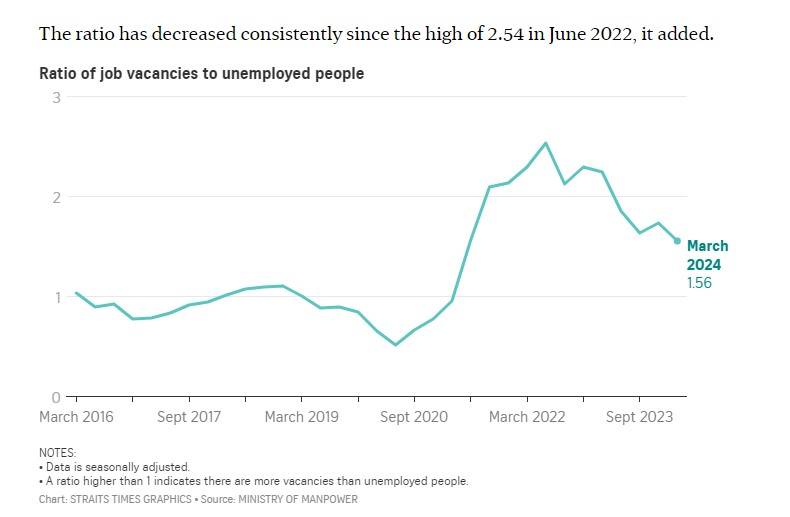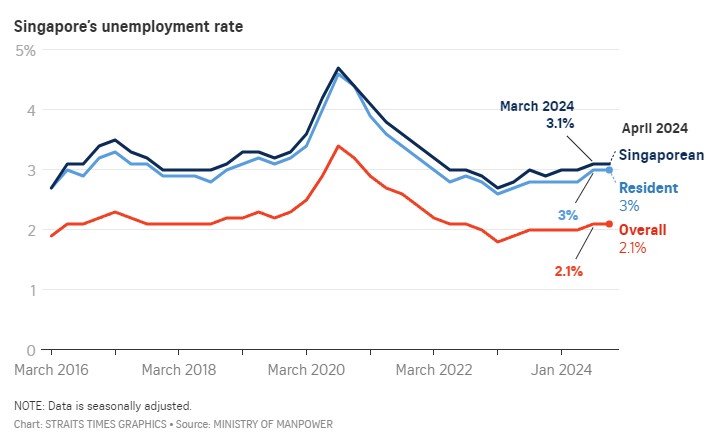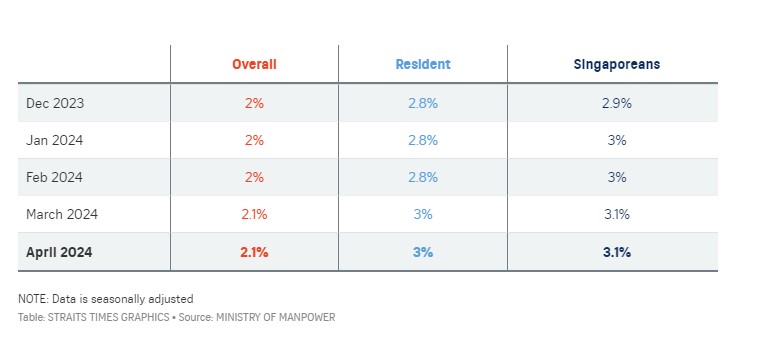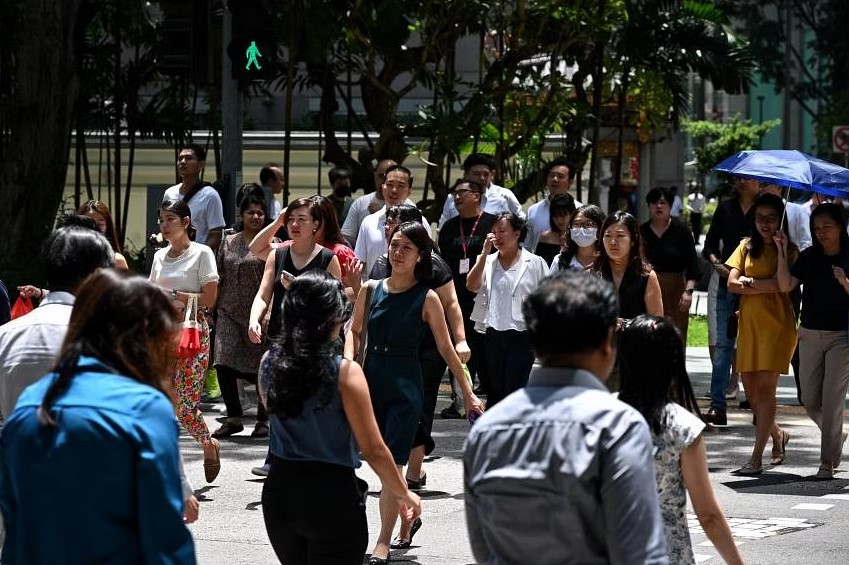Singapore job vacancies rose in March 2024 despite a slight increase in the number of unemployed. The latest quarterly report on the labour market paints a mixed picture. Nevertheless, the labour market remains tight with more vacancies than jobseekers, the Ministry of Manpower (MOM) said in its report on the final labour market data for the first quarter of 2024. 79,800 job vacancies were registered in December 2023, compared with 81,900 in March 2024. “This reflects an improving economic outlook for 2024,” MOM said. Nearly one-third of all job vacancies were in growth industries offering higher productivity and better salaries.

These include health and social services, information and communications, professional services, and financial and insurance services. According to MOM, the ratio of job vacancies to unemployed people fell from 1.74 in December 2023 to 1.56 in March 2024, reflecting a slight increase in the number of unemployed people, although the number of job vacancies increased. At the same time, the number of layoffs fell for the second consecutive quarter, from 3,460 in Q4 2023 to 3,030 in Q1 2024. The layoff rate in Q1 2024 reached 1.3 per 1,000 employees, while in Q3 2023 the layoff rate was 1.9 per 1,000 employees. MOM noted that this is lower than pre-pandemic levels, as the quarterly average from 2015 to 2019 was 1.7 per 1,000 employees. The ministry said the decline in layoffs was due to fewer layoffs in external-facing sectors such as wholesale trade and electronics manufacturing. In the wholesale industry, the number of layoffs fell from 510 to 330 between the fourth quarter of 2023 and the first quarter of 2024.
The number of layoffs in the electronics manufacturing industry fell from 540 to 190 companies during the same period. The number of layoffs in the information and communications sector also fell from 620 to 580 during the same period, but remains at a high level compared to other industries, the ministry said. Corporate restructuring and restructuring continued to be the most commonly cited reason for job cuts by companies. Layoffs due to recession, economic slowdown and high costs declined. However, MOM also noted in its report that the proportion of laid-off workers who were able to return to work six months after layoff fell slightly to 59.4% from 61.5% in the previous quarter. The decline in re-entry rates was observed in the information and communications, financial and insurance services and professional services sectors.

However, MOM said more than half of laid-off workers in these sectors were still able to find new jobs within six months. Nevertheless, MOM said the long-term unemployment rate for domestic residents rose to 0.8% in March 2024 from 0.7% in December 2023, although the figure remains low. The rise in the resident long-term unemployment rate was driven by those under 30, who increased from 1% to 1.2%, and those over 60, who increased from 0.7% to 0.9%. “For residents under 30, the rise in the long-term unemployment rate could be due to these people waiting for better jobs or taking time to explore alternative career options after graduation,” MOM said.
“The long-term unemployment rate for residents aged 60 and above remained at a level comparable to the pre-pandemic level of 0.8%.” While the overall unemployment rate reached 2.1 percent, the unemployment rate for residents was 3 percent and for Singaporeans was 3.1 percent. “Residents” refers to Singaporeans and permanent residents. This is slightly higher than the previous month, but MOM said the rate remains within the range seen in non-recessionary periods.
The report also noted that while employment growth slowed, all of the increase was from Singaporeans and permanent residents, as the number of employed foreigners fell by 800, the first decline since the third quarter of 2021. Among residents, financial and insurance services, public administration, health and social services, administrative and support services, and education led employment growth. However, employment for residents in low-wage sectors such as retail and food services continued to decline after a seasonal increase in the fourth quarter of 2023. MOM said the decline in foreign employment was mainly driven by the construction and manufacturing sector, which has recorded positive employment growth for the past two years as lower foreign worker quotas were implemented.

MOM noted that the number of S Pass holders recorded negative growth in the first quarter of 2024, after an increase in salaries and duties for S Pass eligibility in 2023. The number of work permit and other passport holders increased, but this decline slowed significantly compared to the previous quarter. The number of work permit (EP) holders also recorded negative growth, marking the first decline since the end of 2021. According to MOM, sectors that saw a decline in the number of EP holders included information and communications and professional services, which continue to face global headwinds.
The number of EP holders also increased in other sectors, including wholesale trade, transport and warehousing. MOM said EP applications are increasing overall, in line with the improving economic outlook. “Easing labour market pressures and modest employer intentions to raise wages will likely contain business costs and moderate core inflation through 2024,” said Chua Hang Teng, an economist at DBS Bank. Despite the improving global economic environment, companies may restructure to make their supply chains more resilient, get ahead of tariffs and adapt to technological advances such as artificial intelligence, said Selena Lin, chief economist at OCBC Bank.

Regarding the decline in the reemployment rate within six months of being fired despite the rise in vacancies, Lin said the vacancies could be in certain high-growth fields such as AI and cloud computing, which could lead to further turnover. He added that the labour market has cooled from a strong performance, and noted that MOM does not expect the unemployment rate to continue to rise. “However, wage growth may slow further going forward and it will be interesting to see whether it can keep pace with inflation,” he said.




